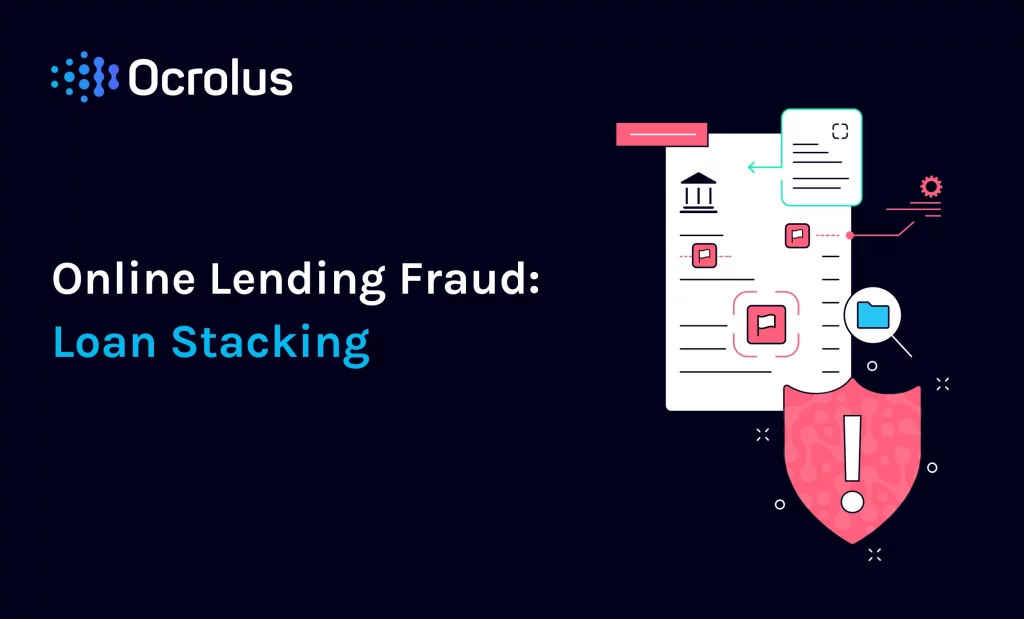This website uses cookies so that we can provide you with the best user experience possible. Cookie information is stored in your browser and performs functions such as recognising you when you return to our website and helping our team to understand which sections of the website you find most interesting and useful.
Online Lending Fraud: Loan Stacking

In 2015, a TransUnion study of lenders in the FinTech industry found that loan stacking represented $39 million of $497 million in charge-offs. At the same time, the number of borrowers engaged in loan stacking doubled between 2013 and 2015.
Loan stacking is a form of loan fraud that’s on the rise.. Read this blog to learn how loan stacking works, and what online lenders can do to combat this fraud with innovative technology.
What Is Loan Stacking?
Loan stacking is when a borrower takes out multiple loans from various lenders at the same time. Not all loan stackers are fraudsters. Some borrowers simply take out several loans simultaneously. This is a practice that lenders are wary of due to the risk incurred. But what separates fraudsters from regular borrowers is that bad actors have no intention of paying the loans back.
As the Wall Street Journal reports, the data makes clear that loan stacking is strongly correlated with fraud. Borrowers who take out a second loan within 15 days are four times as likely to be fraudsters. A third loan makes borrowers 10 times as likely to be fraudsters. The likelihood of fraud increases with each successive simultaneous loan.
Fraudsters will typically engage in loan stacking with stolen or synthetic identities. This makes the loans uncollectible. Some fraudsters will take out loans and pay them back on time to build up good credit. When the time is right, the fraudsters will stack as many loans as possible, and then disappear without paying the funds back.
Fraudsters typically exploit delays in credit reporting to stack loans. They apply for multiple loans before new accounts or credit inquiries can appear on a credit file. Fraudsters apply for many different loans at the same time to maximize the open credit window.
If lenders update credit reports on a daily basis, with activities such as hard inquiries, the fraudster’s behavior will become apparent more quickly. But new account activity can sometimes take 30 days, or even longer, to show up on a credit file. And most creditors will report account activity about once a month.
But no matter the credit reporting method, there’s still almost always a period of blindness built into the loan decisioning process. Even when bank accounts are linked via data aggregators, pending transactions can take 24 hours or more to appear. This gives fraudsters the opportunity to trick multiple funders on the same day.
Loan stacking exploits not just the slowness of credit reporting, but also the rapidity of the online financing process. Online lenders often move as quickly as possible to beat their competition to a deal. This combination of fast loan decisioning and delayed credit reporting is a potent combination for fraudsters. Loan stacking is growing with the advent of these quick decisioning models.
Fraudsters can also engage in long term loan stacking over a period of months or years. For instance, a fraudster might take out a loan, use it to pay an existing loan, and then take out another loan to pay that one, and so on. It’s also sometimes difficult to identify loan stacking at the transaction level, because lender payments are purposely obscured, or hidden under an alias.
Fighting Back Against Loan Stacking: Key Technology Solutions
Although the problem continues to grow, lenders can fight back against loan stacking using innovative technology. Here are some key solutions that combat the unique fraud vectors generated by loan stacking.
Clarity, an Experian company, offers a Temporary Account Record that fights back against loan stacking. The Temporary Account Record enables aggregation and reporting of approved but not yet formally reported commercial transaction data such as loans, credit cards, insurance, and commercial contracts.
Clarity’s Temporary Account Record not only detects the current loans of an applicant, but also any pending loan transactions that have not been finalized. The data helps online lenders fight loan stacking by detecting loans before they’re officially reported in the crucial first 30 days.
Another solution that fights loan stacking is Ocrolus. The Ocrolus platform analyzes financial documents with 99% accuracy, including bank statements, and offers transaction-level loan stacking detection. Using business intelligence taken from 50+ top lenders, Ocrolus identifies stacked loans on financial documents.
Ocrolus deciphers loan payments that are made under an alias or are otherwise hidden through ongoing input from the platform’s network of partner lenders, providing a systematic defense against loan stacking.
Loan Stacking: A Serious But Containable Threat
Loan stacking techniques will grow more sophisticated in the coming years, and lenders must remain ready to fight back. But there are currently a number of technology solutions that tackle the problem head on. Lenders can reduce losses due to loan stacking by leveraging the right combination of these solutions.
But to build a comprehensive anti-fraud strategy, lenders must develop integrated solutions that combat all forms of online lending fraud. Check out our other blogs on online lending fraud for ideas on how to fight back on all fronts.





